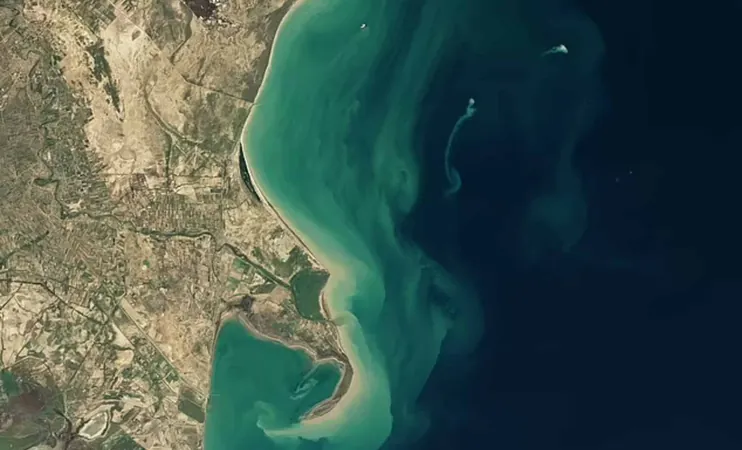
NASA Uncovers Enigmatic Ghost Island in the Caspian Sea: Nature's Marvel or Catastrophe Waiting to Happen?
2025-01-13
Author: Ying
The Sudden Emergence of an Illusive Landmass
Emerging in early 2023 following a vigorous eruption from the Kumani Bank mud volcano, this ghost island caught the attention of scientists as it dramatically showcased the geological volatility of the area. Satellite imagery tracked its brief existence, describing its disappearance as akin to an “apparition.” This phenomenon highlights not only the ephemeral nature of such geological features but also the intriguing processes behind their formation and erosion.
Mud volcanoes like Kumani Bank are extraordinary geological formations capable of explosively ejecting mud, gas, and sediment. Historical records indicate that this volcano has produced similar fleeting islands multiple times since its initial eruption in 1861. Such transient landmasses are a testament to the dynamic forces at work in the tectonically active Caspian region, leading to the creation and rapid erosion of land.
The History of the Kumani Bank Mud Volcano
Located approximately 25 kilometers (15 miles) off Azerbaijan’s eastern coast, the Kumani Bank mud volcano has a rich history of explosive eruptions that give rise to short-lived islands. Its first recorded eruption, which occurred in May 1861, produced an island merely 87 meters (285 feet) wide and 3.5 meters (11.5 feet) high before it was eroded within a year. The 2023 event followed this pattern, with NASA's Landsat satellites meticulously documenting the life cycle of the island from its formation to its eventual disappearance by late 2024.
This geological phenomenon is particularly pertinent as it provides invaluable insights into the forces shaping our planet's surface. The interplay between erosion and subsurface pressures poses intriguing questions about the future of such transient features.
Tectonic Forces at Play
The Caspian Sea lies in a unique tectonic convergence zone, where the Arabian and Eurasian plates collide. This tectonic activity has resulted in Azerbaijan being home to more than 300 mud volcanoes, offering a spectacular display of geological power. Many of these volcanoes are located on land, but the Kumani Bank stands out for its ability to consistently produce islands.
While the specifics of the 2023 eruption’s intensity remain unclear, prior events in the region have generated fiery explosions with flames reaching hundreds of meters into the sky. This volatile and unpredictable behavior of mud volcanoes adds to their allure as both geological wonders and sources of potential hazard.
Lessons from Mud Volcanoes
Despite being understudied, mud volcanoes are rich in information about subsurface geological processes. They erupt when built-up pressures force mud and gas to the surface, particularly in hydrocarbon-rich areas. The that characterize the Caspian region, combined with its tectonic activity, allow for these striking events to unfold, offering a prime opportunity for scientific study.
Geologists note that Azerbaijan’s concentration of mud volcanoes is remarkable. The Kumani Bank volcano has produced varying sizes of islands over the decades, with the 2023 event allowing real-time observation and analysis via satellite imagery—a rare chance to closely study the effects of such eruptions.
Nature’s Double-Edged Sword
While the phenomenon of ghost islands is captivating from a scientific standpoint, it also carries significant risks. Sudden eruptions can unleash gas and debris into the surrounding environment, posing dangers to local ecosystems and human infrastructures alike. The potential for explosive eruptions adds another layer of concern, reminding us of the immense power that lies within the Earth.
Future investigations of the Kumani Bank mud volcano and other similar geological features will undoubtedly continue to unravel mysteries about our planet's ever-changing landscape. As we learn more about these striking ghost islands, we are constantly reminded of the unpredictable and fascinating forces that continue to shape our world.


 Brasil (PT)
Brasil (PT)
 Canada (EN)
Canada (EN)
 Chile (ES)
Chile (ES)
 Česko (CS)
Česko (CS)
 대한민국 (KO)
대한민국 (KO)
 España (ES)
España (ES)
 France (FR)
France (FR)
 Hong Kong (EN)
Hong Kong (EN)
 Italia (IT)
Italia (IT)
 日本 (JA)
日本 (JA)
 Magyarország (HU)
Magyarország (HU)
 Norge (NO)
Norge (NO)
 Polska (PL)
Polska (PL)
 Schweiz (DE)
Schweiz (DE)
 Singapore (EN)
Singapore (EN)
 Sverige (SV)
Sverige (SV)
 Suomi (FI)
Suomi (FI)
 Türkiye (TR)
Türkiye (TR)
 الإمارات العربية المتحدة (AR)
الإمارات العربية المتحدة (AR)